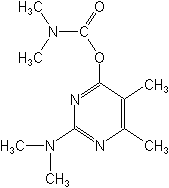-
Common NamePirimicarb
-
中文通用名抗蚜威
-
IUPAC2-dimethylamino-5,6-dimethylpyrimidin-4-yl dimethylcarbamate
-
CAS2-(dimethylamino)-5,6-dimethyl-4-pyrimidinyl dimethylcarbamate
-
CAS No.23103-98-2
-
Molecular FormulaC11H18N4O2
-
Molecular Structure
-
Category
-
ActivityAphicide
-
PremixLambda-cyhalothrin+pirimicarb
Imidacloprid+pirimicarb
Aerosol, dispersible grain, dispersible powder, emulsifiable concentrate, smoke generator, ULV spray. Premix Parters: daimuron; dimethametryn; dimethametryn esprocarb pyrazosulfuron-ethyl; pyrazosulfuron-ethyl;
-
Physical PropertiesMolecular weight:238.3; Physical form:White solid. Density:1.18 (25 °C); tech. 1.21 (25 °C); Composition:Tech. material is 95% pure. Melting point:91.6 °C; Vapour pressure:4 × 10-1 mPa (20 °C, by interpolation); Henry constant:3.6 10-5 Pa m3 mol-1 ( calc.); Partition coefficient(n-octanol and water):logP = 1.7 (unionised); pKa:4.44 (20 °C), weak base; Solubility:In purified water 3.0 g/l (20 °C). In acetone, methanol, xylene >200 g/l (20 °C).; Stability:Stable under normal storage conditions for more than 2 years. Hydrolytically stable at pH 4-9 (25 °C). Aqueous solutions are unstable to u.v. light; DT50 <1 d ( pH 5, 7 or 9).
-
ToxicologyOral:Acute oral LD50 for female rats 142, mice 107, dogs 100-200 mg/ kg. Percutaneous:Acute percutaneous LD50 for rats >2000, rabbits >500 mg/kg. Non-irritating to skin; mild irritant to eyes (rabbits). Moderate skin sensitiser (guinea pigs M & K). Inhalation: LC50 (4 h) for female rats 0.86 mg/l.
-
Environmental ProfileEcotoxicology:
Algae: EC50(96 h) 140 mg/l.Bees:Not toxic to bees. LD50(24 h) (oral) 4µg/bee ( tech.); (contact) 53µg/bee ( tech.).Birds:Acute oral LD50for poultry 25-50, mallard ducks 28.5, bobwhite quail 20.9 mg/ kg.Daphnia: EC50(48 h) 0.017 mg/l.Fish:LC50(96 h) for rainbow trout 79, bluegill sunfish 55, fathead minnow >100 mg/l.Worms:LC50(14 d) >60 mg/ kg.Other aquatic spp.: EC50(48 h) for Lymnaea stagnalis 19, Gammarus pulex 48, Chironomus riparius 60 mg/l.Other beneficial spp.:Not toxic to Collembola (J. A. Wiles & G. K. Frampton, Pestic. Sci., 47, 273 (1996)).
Environmental fate:
Animals:In mammals, the major metabolites are 2-dimethylamino-5,6-dimethyl-4-hydroxypyrimidine, 2-methylamino-5,6-dimethyl-4-hydroxypyrimidine, 2-amino-5,6-dimethyl-4-hydroxypyrimidine and 2-dimethylamino-6-hydroxymethyl-5-methyl-4-hydroxypyrimidine.Soil:For details of degradation in soil, see I. R. Hill, ACSSymp. Series, 1976, 29, 358. DT50in soil 7-234 d, according to soil type. WATER SOLUBILITY: 0.27% HAZARDS: Fish, Bee: Nontoxic -
Transport InformationSignal Word:WARNING; Hazard Class:II(Moderately hazardous)
Porduct NewsMore
Australia permitted emergency use for PIRIMOR® to combat Russian wheat aphid
Related CompaniesMore
Shaanxi Sunger Road Bio-science Co., Ltd
Country: China
Tribenuron Methyl+Carfentrazone-ethyl+Fluroxypyr-meptyl Florasulam+MCPA-isooctyl+fluroxypyr-meptyl Abamectin+Methoxyfenozide Thifluzamide+Azoxystrobin β-sitosterol Hexaconazole+Phenamacril Pymetrozine+Lambda-cyhalothrin Pymetrozine+Dinotefuran Spirotetramat+Pymetrozine Pyraclostrobin + Cyazofamid
Anhui Huaxing Chemical Industry Co., Ltd.
Country: China
Kresoxim-methyl Cartap Glyphosate Imidacloprid Nicosulfuron MCPA-2-ethylhexyl Flusilazole Thiosultap-monosodium MCPA Fipronil
Country: China
Clethodim Hexazinone Mesotrione Abamectin Acetamiprid Dimethoate Fipronil Imidacloprid Fosetyl-aluminium 2,4-D
Hunan Haili Chemical Industry Co., Ltd.
Country: China
Carbofuran Carbosulfan Propoxur Fenobucarb/BPMC lsoprocarb/MIPC Carbaryl Methomyl Dimethoate Pirimiphos-methyl Thiodicarb Thiophanate-methyl

 0
0 Subscribe
Subscribe
